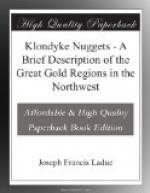“What the Amazon is to South America, the Mississippi to the central portion of the United States, the Yukon is to Alaska. It is a great inland highway, which will make it possible for the explorer to penetrate the mysterious fastnesses of that still unknown region. The Yukon has its source in the Rocky Mountains of British Columbia and the Coast Range Mountains in southeastern Alaska, about 125 miles from the city of Juneau, which is the present metropolis of Alaska. But it is only known as the Yukon River at the point where the Pelly River, the branch that heads in British Columbia, meets with the Lewes River, which heads in southeastern Alaska. This point of confluence is at Fort Selkirk, in the Northwest Territory, about 125 miles south-east of the Klondyke. The Yukon proper is 2,044 miles in length. From Fort Selkirk it flows north-west 400 miles, just touching the Arctic circle; thence southward for a distance of 1,600 miles, where it empties into Behring Sea. It drains more than 600,000 square miles of territory, and discharges one-third more water into Behring Sea than does the Mississippi into the Gulf of Mexico. At its mouth it is sixty miles wide. About 1,500 miles inland it widens out from one to ten miles. A thousand islands send the channel in as many different directions. Only natives who are thoroughly familiar with the river are entrusted with the piloting of boats up the stream during the season of low water. Even at the season of high water it is still so shallow as not to be navigable anywhere by seagoing vessels, but only by flat-bottomed boats with a carrying capacity of four to five hundred tons. The draft of steamers on the Yukon should not exceed three and a half feet.
“The Yukon district, which is within the jurisdiction of the Canadian Government and in which the bulk of the gold has been found, has a total area, approximately, of 192,000 square miles, of which 150,768 square miles are included in the watershed of the Yukon. Illustrating this, so that it may appeal with definiteness to the reader, it may be said that this territory is greater by 71,100 square miles than the area of Great Britain, and is nearly three times that of all the New England States combined.
“A further fact must be borne in mind. The Yukon River is absolutely closed to navigation during the winter months. In the winter the frost-king asserts his dominion and locks up all approaches with impenetrable ice, and the summer is of the briefest. It endures only for twelve to fourteen weeks, from about the first of June to the middle of September. Then an unending panorama of extraordinary picturesqueness is unfolded to the voyager. The banks are fringed with flowers, carpeted with the all-pervading moss or tundra. Birds countless in numbers and of infinite variety in plumage, sing out a welcome from every treetop. Pitch your tent where you will in midsummer, a bed of roses, a clump of poppies and a bunch of bluebells will adorn your camping.




